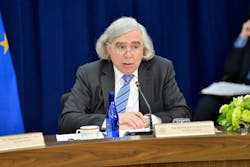Water sector leaders share policy and research priorities with Energy Secretary Moniz
DENVER, CO, SEPTEMBER 14, 2016 -- Water policy and research priorities were the focus in a September 7 meeting of water industry leaders with U.S. Energy Secretary Ernest Moniz. Seven organizations representing utilities that provide service to 90 percent of the population in the United States served by drinking water, wastewater, resource recovery, reuse, and stormwater systems discussed issues and common concerns in the energy-water-food nexus with the Secretary, as well as explored opportunities for collaboration with the Department of Energy (DOE).
The group presented the water community’s energy and water management challenges and opportunities in water supply, treatment, and resource recovery, including:
- Legislation, Policy, and Regulation that Support Life Cycle Environmental Responsibility
- Alternative Water Resources, Availability and Demand, Treatment
- Emerging Technologies and Processes
- Energy Efficiency, Water Conservation, and Demand Response
- Energy Recovery and Generation
- Climate Change Impacts
- Reliability and Resiliency
- Systems Complexity, Regional Challenges
The water-sector organizations at the meeting included the Water Research Foundation, Water Environment & Reuse Foundation, Water Environment Federation, American Water Works Association, National Association of Clean Water Agencies, Association of Metropolitan Water Agencies, and National Association of Water Companies. They are the leading national water sector research, educational, and advocacy organizations with memberships consisting of the majority of the large and medium U.S. water/wastewater utilities, plus consulting, manufacturing, academia, government, and other related stakeholders.
The group promotes the view that research and collaboration between the energy and water sectors can result in reliable, resilient, and sustainable systems that will stimulate energy efficiency and water conservation to benefit the customers we serve, public health, the economy, and the environment. DOE asked the organizations to provide further detail on the efforts that have shown promise in the identified areas of challenge and opportunity, with suggestions on the strongest opportunities for further support.
The Association of Metropolitan Water Agencies is an organization of the largest publicly owned drinking water suppliers in the United States.
Established in 1881, the American Water Works Association is the largest nonprofit, scientific and educational association dedicated to managing and treating water, the world’s most important resource. With approximately 50,000 members, AWWA provides solutions to improve public health, protect the environment, strengthen the economy and enhance our quality of life.
The National Association of Clean Water Agencies is the leading advocate for responsible national policies that advance clean water. NACWA represents the collective interests of America's clean water utilities nationwide – and their clear commitment to America’s waters. For over 40 years, NACWA has been the clean water community’s voice in Congress, at the U.S. Environmental Protection Agency and other federal agencies, as well as in the media and in the courts. To learn more about NACWA visit us at www.nacwa.org.
The National Association of Water Companiesis the voice of the private water industry and the organization exclusively representing this group of quality water service providers, innovation drivers, creative financiers and responsible partners. Nearly one in every four Americans receives service from a privately-owned water or wastewater utility or a municipal utility operating under a public-private partnership.
The Water Environment Federation is a not-for-profit technical and educational organization of 34,000 individual members and 75 affiliated Member Associations representing water quality professionals around the world. Since 1928, WEF and its members have protected public health and the environment. As a global water sector leader, our mission is to connect water professionals; enrich the expertise of water professionals; increase the awareness of the impact and value of water; and provide a platform for water sector innovation. To learn more, visit www.wef.org.
The Water Research Foundation is an internationally recognized leader in sponsoring research that supports the water community in holistically and cooperatively managing water from all sources to meet social, environmental, and economic needs. WRF’s research provides reliable and relevant solutions to the most critical challenges facing the water community today and into the future. Founded in 1966, WRF is a 501(c)(3) non-profit organization that has sponsored nearly 1,500 research projects valued at $500 million, and serves more than 1,000 subscribing organizations. For more information, go to www.WaterRF.org.
The Water Environment & Reuse Foundation (WE&RF) is a 501c3 charitable corporation seeking to identify, support, and disseminate research that enhances the quality and reliability of water for natural systems and communities with an integrated approach to resource recovery and reuse; while facilitating interaction among practitioners, educators, researchers, decision makers, and the public.
